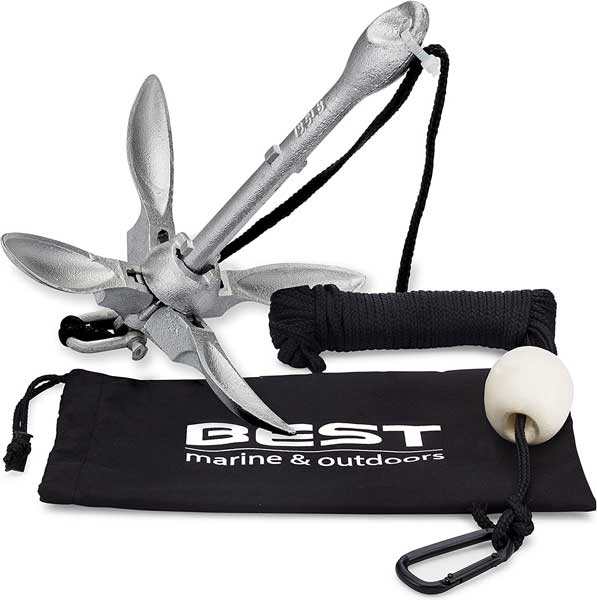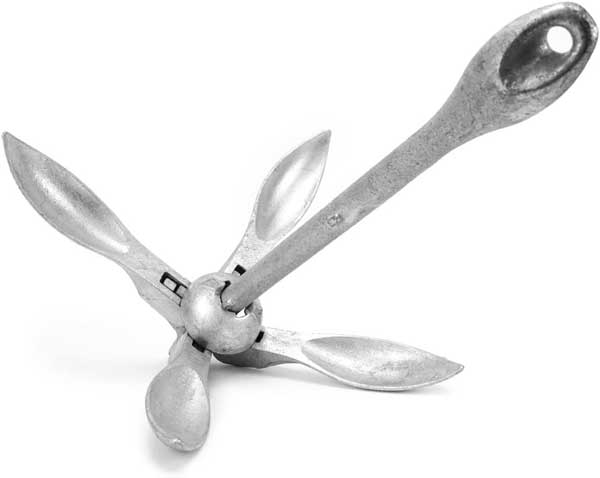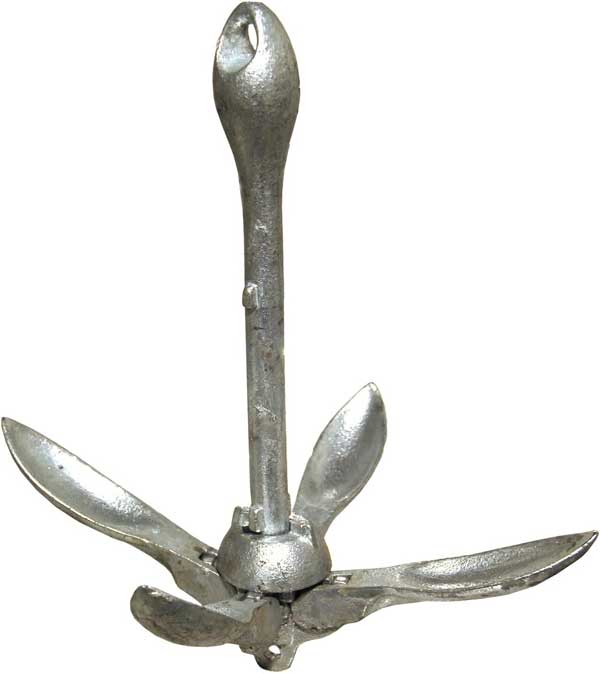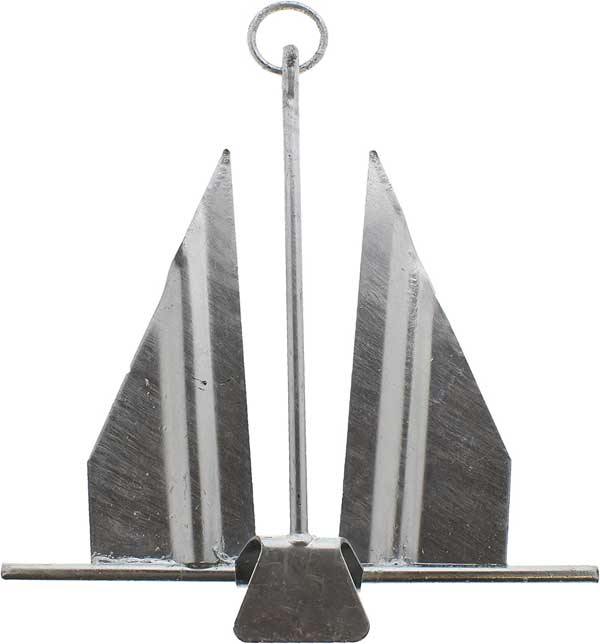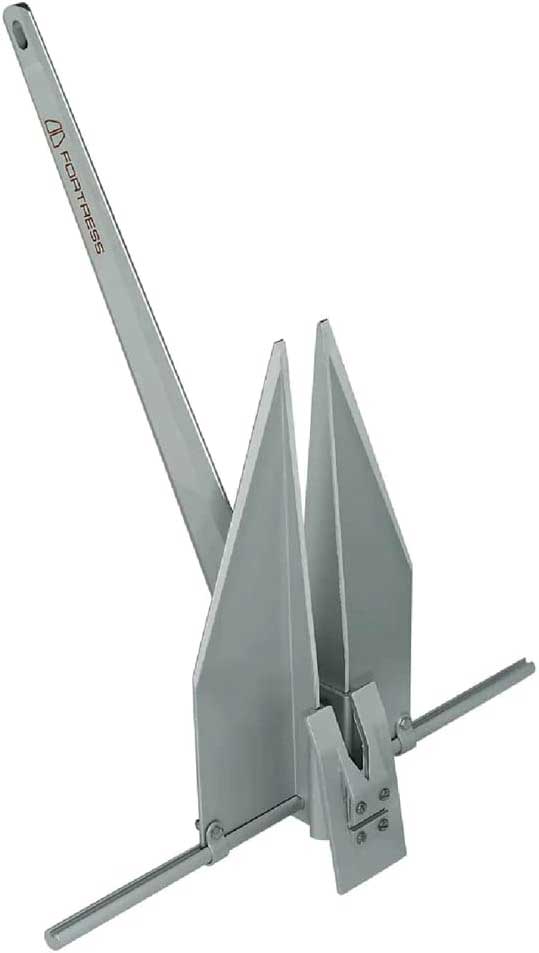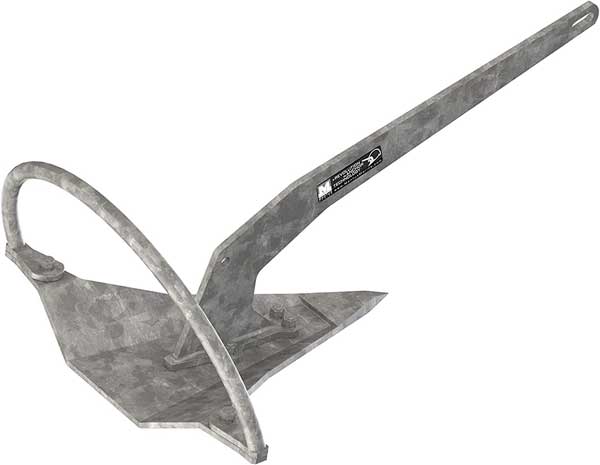I remember my first boat, I was so fired up and excited about getting it on the lake. We got it docked then I realized, there is no anchor. I don’t know anything about anchors, so what is the best anchor for your boat or Kayak? That is what we will discuss in this article.
Here we are going to look at the most popular types of anchors, their specifications, features and target and how they are best used.. Moreover, we have compared the anchors and pointed out their differences to help you choose the right one. Also, our team has tried to put it simply, so that the information is useful and understandable to novices and helpful to even experienced sailors. Moreover, keen, but not necessarily experienced, explores can get the advantage of using the best marine GPS Chartplotter to check out new places where to cast their anchor.
Basically, anchors come in two categories, depending on their purpose. If you are going to drop your anchor and let your boat stay at that spot permanently, then you will need the mushroom or wing and plow type. The other kinds of anchors are designed for temporary use, for example when you go fishing and want to secure your vessel in one place while you are waiting to catch a fish. And we are going to look through to the description of the most common types of anchors below.
Anchors For Permanent Mooring
1. Mushroom Types
This anchor actually resembles the shape of a mushroom but turned upside down. It is convenient for keeping your boat in one place, especially in lake conditions where there is no current, and the bottom is covered with soft substances like mud or sand. Also, its holding power is increased after it reaches the bottom and is “blocked” by the silt.
2. Wing & Plow Anchors
We have decided to combine the description of these two types because they both resemble the same plow design. The only difference is that the wing anchor has a one-piece design, i.e. arm attached directly to the shovel. As for the plow one, there is an extra hinge on the shank for more convenience. And since their style is very similar, their performance at the sea or river bottom will be the same. They are both very appropriate for permanent mooring because they dig well and can resist tidal changes or strong winds. Moreover, these anchors are perfect for almost all bottoms, except for rocky ones.
Anchors For Temporary Mooring
1. Claw Anchors
This type of mooring option is great for all kinds of bottom conditions because the three-claw construction not only digs in more easily but also can be set again without effort if it becomes loose. However, claw anchors do not have so much holding power per pound. Still, you will be delighted with a claw anchor when you drop it in any kind of bottom, no matter whether it is covered with clay, coral or sand. Of course, rocks can be obstacles for mooring from the first time, but claw anchors are still reliable in such conditions.
2. Fluke Anchors
These anchors were used to be called cruising or crown anchors because of their practical design and ability to dig in the bottom effortlessly. They have a stock feature at the head that actually provides security and correct positioning for better digging in. And thanks to its shape, you will have no difficulties to place it in small anchor compartments. Another reason to choose the fluke anchor is because of its perfect performance in sandy and muddy bottoms. Unfortunately, if the underwater surface is somehow different from these two, your anchor will struggle to set in.
3. Plow Anchors With Roll Bar
This type is almost the same as the plow and wing anchor types, but there are essential differences to be pointed out. First, the tip of the plow is sharpened to enhance the penetration into the silt. Second, there is a roll bar that will let you use this anchor even in adverse bottom conditions, for example in hard clay or seaweeds, even amid rocks. However, its storage on your boat can be a bit challenging due to its shape.
4. Grapnel Anchors
The key advantage of this type is that it can conveniently fold to fit in your anchor compartment and hence it saves from your space. It is designed to sit well even in rocky bottoms because of the 4 flukes which will rarely fail to get a grip. Despite that, the structure of this anchor may cause you troubles as there is a chance for your chain or rope to get wrapped around the fluke sticking out of the bottom.
Maintaining Your Anchor
Getting the most suitable anchor for your watercraft is not the end of the mooring process. A brand new river anchor will surely stabilize your boat in the water. But what happens after having it for more extended periods? And what if your prime target fishing area, for example, is the sea or the ocean?
There are even more questions that you may ask yourselves concerning your anchors’ maintenance and we will not let you wonder anymore. After all, the excellent condition of your anchor is directly linked to the safety of all the people on the vessel. So, scroll down for some essential advice on your anchor aftercare procedures.
If your anchor is exposed to strong tides and rough weather conditions, this means it will wear faster. In this case, you have to check the status of your anchor
Salty water in seas or oceans can lead to the corrosion of your anchor. You can either clean the anchor regularly after raising it from the bottom or consider applying a sealant for better protection.
Try not to keep your anchor in the water during the winter. If this is not possible, make sure to indicate its position with a buoy, so that the riser does not sink.
Clean your mooring device thoroughly for boats before storing it into the anchor compartment to ensure no fine particles like sand or small lumps of clay are going to linger there. Such dirt may erode the material of your anchor and lead to dangerous situations.
Before bringing up the matter of proper boat securing, you may wish to check out our exclusive marine vessels’ accessories, hot tips and extensive guides for more information, advice and help to contribute to your sailing events.
Using Your Anchor The Right Way
Now that you know how to make sure you keep your anchor in good condition, it is time to discuss the proper installation and use of your mooring device. But first, we will focus on all the tools you need before casting your anchor and also explain why they are essential.
-
Anchor Rope
Make sure you have 3 ft of rope for every 1 ft of depth. If you do not know what anchor line to use, you should definitely check out our best anchor rope and chain for more information about types, materials and hot tips when choosing one.
-
Chain & Anchor Shackle
The chain you will use should be at about 4 or 5 ft long. Chains are essential because they take the wave off the anchor and therefore, the tension will be on the connected rings of metal, not the anchor.
-
Anchor
Step By Step Installation
It is not enough just to tie the rope to the anchor; it is a way more than that, but that does not mean it is difficult.
- Take the end of your chain and put the anchor shackle through it.
- Tie up the anchor and the chain together.
- Take the other end of the chain and clip it up with the rope.
- Ease the anchor down in a steady manner and let it go down to the bottom.
Safety Tips For Boat Anchors
Here we are going to give you some practical, helpful and definitely essential advice concerning your personal protection when using your anchors.
- Use the right anchor for your boat’s measurements and do not forget to take into account the type of sea bed.
- Proper anchoring aims to avoid setting the anchor in an upright position because it is not designed to grab like that. Its purpose is actually to tilt and hence dig in. Still, you have to be careful since your boat might get shifted by the waves and this way your vessel can pull up the rope which will lead to your anchor standing right up and sliding across the bottom. That is why our team recommends using at least 5ft of the chain in combination with a rope.
- Lay the anchor and the rope correctly and make sure you do not coil it up in a big pile or you will have difficulties with the anchor release system.
You should carefully attempt every maneuver and ensure everything is under control. - Do not forget to ensure that you are not dragging your anchor.
- Always place in your boat a secondary anchor.
Best Boat Anchors Comparison Chart
| PRODUCT | PRICE | DIMENSIONS | WEIGHT | MADE |
|---|---|---|---|---|
| BEST Marine and Outdoors Kayak Anchor | $$ |
12 x 3 x 3″
|
3.5 pounds | Galvanized |
| Crown Sporting Goods Folding Grapnel Boat Anchor | $$$ | 9.4 x 1.8 x 1.8″ | 17.5 pounds | Galvanized |
| Danielson Anchor | $$ | 7 inches long | 1.5lb. | Galvanized |
| SeaSense Anchor #15 Slip Ring Econo | $ | 18 x 23 x 3″ | Approximately 9lb | Galvanized |
| Fortress FX-7 Anchor | $$$$ | 25 x 5 x 3″ | 4 pounds | Aluminum alloy |
| Mantus Marine Anchor | $$$$ – $$$$$ | Variable Options | Variable Options | Galvanized |
BEST BOAT ANCHOR REVIEWS (TOP PICKS)
The beginning of our guide is all about those popular products which you will definitely be interested in. Here we have pointed out their benefits and functionality without forgetting to mention the drawbacks you may experience with each of them.
1. BEST Marine and Outdoors Kayak Anchor
Our first product in the list caught our attention with its compact and functional design. The BEST Marine and Outdoors anchor weighs only 3.5lb and is 12×3 inches in size when it is folded, which makes it perfect for boats of up to 11ft in length. What is more, you will get a vinyl storage bag with a drawstring to keep your anchor in a safe place when it is not put in use. Also, the material this unit is made of – galvanized steel, will surely prolong the life of the kayak anchor because it is resistant to rust. Hence, the overall appearance and practicality of the product will definitely suit your needs to get a better hold and more horizontal drag in sandy, weedy or even rocky bottoms. However, this unit is not appropriate for strong currents or rough weather conditions, especially in the ocean, as it is not heavy enough to withstand them and your vessel may quickly flip over.
Pros
- 4-fluke grapple design
- 8 in x 40ft long rope
- Can be used with an anchor trolley
- 1-year guarantee
- Hard foam buoy
Cons
- No reel in the package
- You have to attach the rope to the anchor
2. Crown Sporting Goods Folding Grapnel Boat Anchor
What really impressed our team in this product is the size of the anchor. With its 17.5lbs, the Crown Sporting Goods unit is just what you need for your pontoon boat, canoe or dinghy. The impressive weight of the anchor will prevent your vessel from floating away no matter whether you are in a lake, pond or in the open sea. Also, this product is appropriate for a variety of bottom water – from stone and gravel to heavy weeds and coral. But you should be careful if the water bed is predominantly covered with mud as the prongs may not bite well. Yet, with its dimensions of 9.4 x 1.8 x 1.8 inches when folded, this grapnel boat anchor will not take up much space in your watercraft. And we think this unit’s practical size and weight will be the perfect addition to your fishing, camping or recreational sports activities.
Pros
- Made of galvanized steel
- 4-prong structure
- Easy to lock with a simple rotation mechanism
- Perfect for watercraft of up to 24ft in length
Cons
- The package does not include D-ring, anchor line or any other features
- The lock nut might get wobbly after continual use
3. Danielson Anchor
Here we have a tiny anchor that weighs only 1.5lb. But you should not be deceived by its modest size because Danielson’s product will definitely pay off. This unit has 4 prongs and reaches 7 inches wide when open.
Moreover, it comes with a locking mechanism that can be used in both folded and unfolded positions. Also, the galvanized anchor is just what you need for your small vessels like kayaks or inflatable boats as it will secure them in one place when you decide to cast the anchor in rocky or sandy bottoms. However, this little product will only work well if there are mild currents and no wind, otherwise your inflatable boats, for example, will not be moored at all. And another thing that you may want to do is use a chain instead of a rope, to add extra strength to this anchor. Finally, make sure you do not force the locking mechanism too much because it may easily break.
Pros
- Can be locked in an open and closed position
- Great for small boats of up to 9ft
- 7 inches long
- Small-scale size
Cons
- Will not hold up the vessel when windy
- Brittle castings
4. SeaSense Anchor #15 Slip Ring Econo
Our next product comes with a lightweight design and reliable holding power. The materials used for the manufacturing of the SeaSense slip ring anchor do not make it heavy, and therefore it is easy to carry, store and put into use. Besides, its galvanized construction protects the anchor from rust and corrosion which is essential when used in saltwater. However, coating this slip ring anchor’s cutoff with a sealant will make it more durable. Still, the size of the unit is quite impressive, and with its dimensions of 18x23x3 inches and approximately 9lb weight, the product can hold your boat in one place even in strong currents. And obviously, this makes it really functional and convenient for river fishing. What is more, the unit’s design will not only help you secure your watercraft when unexpected obstacles occur, but you will also quickly raise this slip ring anchor. Despite that, you should still be careful as the anchor may get bent when dropped in rocky bottoms.
Pros
- An aluminum-magnesium anchor
- Reasonable price
- Perfect for boat sizes from 21 to 23 inches
- Great for all bottom conditions
Cons
- Might be too long to fit the anchor compartment
- Better used as a second anchor
5. Fortress FX-7 Anchor
Our last but one anchor in the list weighs only 4 pounds but has the holding power of a much more massive anchor. This is because this Fortress’ product is made of aluminum alloy that is as strong as steel anchor, but slightly lighter at the same time.
Moreover, this material is resistant to rust and corrosion and therefore durable and easy to maintain. Also, the characteristics of this unit will suit your needs if you own a boat between 16 and 27 inches in length. And if you wonder whether this anchor can fit your anchor compartment, you will find out how easy it is to store it because of its triangular shape, light design, and size of 25x5x3 inches. Although this product will serve as a perfect spare or storm anchor that sticks from the first time you drop it in the water, you might find assembling the unit a bit challenging.
Pros
- Lifetime parts replacement warranty
- Can be disassembled
- Special feature for extra holding power in soft mud bottoms
- 32° to 45° adjustment flake angle
Cons
- Needs to be assembled
- Package does not include a storage bag
6. Mantus Marine Anchor
The last top pick in our product reviews is a little bit more expensive than the others, but we can assure you that it is worthy. The Mantus Marine anchor comes in different sizes to fit your boats’ requirements. The only thing to do is to visit the manufacturer’s website for more information on the anchors’ measurements.
Moreover, we can promise you, there are no cast parts on this unit, and therefore, the quality standard set for the anchor is achieved by the use of a steel plate. Another great thing about the product’s construction is the fact that the shank is actually welded to the shank’s boot and then secured with steel bolts to the fluke. Also, the sharp-headed nose of the shovel is strengthened for better performance in grassy, muddy or sandy bottoms. However, we do not recommend using a rope but a chain of at least 4f so that you can get good leverage.
Pros
- Lifetime warranty
- Ideal for weedy bottoms and stormy weather conditions
- Hot-dipped galvanized steel
- ASTM certified steel bolts
Cons
- A bit expensive
- May not fit in small anchor compartments
Wrapping Up
This is the end of our comprehensive guide to give you the most up-to-date information about our best boat anchor reviews and expert advice on what to look for before heading to the store. Our team hopes that now you know exactly what the best boat anchor will fulfill your needs to secure your vessel. And as Popeye’s words ring a bell “I ain’t no tailor, but I know what suits me.”, we believe that at the end of our guide you are ready to make the perfect purchase for your boat.
As always, we are open to your feedback and would appreciate any comment left by you. If you liked the article, show it to your friends or share it online. Let us know if anything can be changed or improved. Thanks for reading and as always – stay put!
Have you checked out our water fun ideas?


